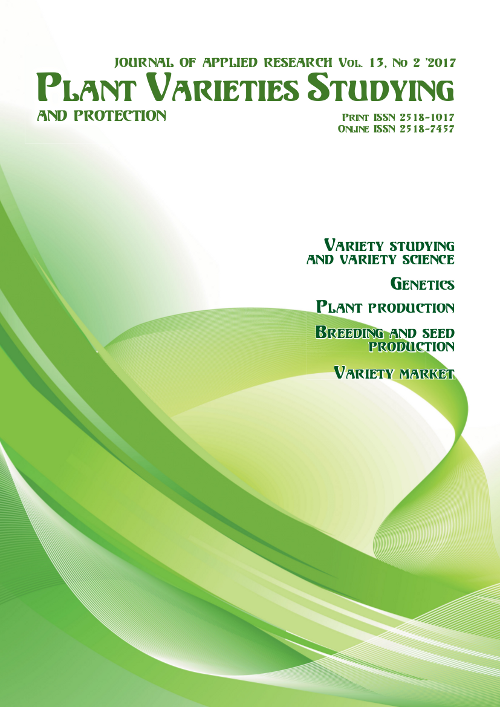Formation of productivity depending on the stability and plasticity of grain sorghum varieties
DOI:
https://doi.org/10.21498/2518-1017.13.2.2017.105396Keywords:
grain sorghum, yielding, stability, plasticityAbstract
Purpose. To evaluate the stability and plasticity of new varieties of grain sorghum in ecological conditions of the Fores-Steppe and Steppe zone of Ukraine.
Methods. Field study, statistical evaluation.
Results. It was found that in Ukraine the average yield of grain sorghum in 2015 was 3.72 t/ha and in 2016 – 3.36 t/ha. In field experiments during 2009–2016, ‘Praim’ and ‘Sprynt 2’ hybrids appeared to be significantly better as compared to averaged yields of 3.9 t/ha. Evaluation of yield plasticity in environmental conditions of the Forest-Steppe and Steppe zones showed that the hybrid ‘Praim’ did not differ from the group standard and its index is no more than one. At the same time, the ‘Sprynt 2’ is highly-plastic hybrid and ‘Dniprovskyi 39’ belongs to relatively low-plastic varieties.
Conclusions. It was established that, as an average of an experiment, hybrids of grain sorghum ‘Praim’ and ‘Sprynt 2’ had a yield of 4,2–4,3 t/ha. According to the analysis of ecological plasticity, ‘Sprynt 2’ can be included with the intensive type and ‘Dniprovskyi 39’ – with relatively low-plastic varieties. It was found that proper selection of varieties and farming practices of cultivation is one of the main factors that favors high yields and respectively determine 37% and 34% of the level of grain sorghum productivity.
Downloads
References
Cherenkov, A. V., Shevchenko, M. S., Dziubetskyi, B. V., Cherchel, V. Yu., Bodenko, N. A., Yalanskyi, O. V., … Benda, R. V. (2011). Sorhovi kultury: tekhnolohiia, vykorystannia, hibrydy ta sorty [Sorghum crops: technology, use, hybrids and varieties]. Dnipropetrovsk: Royal Print. [in Ukrainian]
Alabushev, A. V. (2011). Variety as a factor of innovative development of grain production. Zernovoe khozyaystvo Rossii [Grain Economy of Russia], 3, 1–8. [in Russian]
Ionova, E. V., Gaze, V. L., & Nekrasov, E. I. (2013). Prospects for the use of adaptive zonation and adaptive breeding of crops (review). Zernovoe khozyaystvo Rossii [Grain Economy of Russia], 3, 19–22. [in Russian]
Roslynnytstvo 1990–2016 [Plant production 1990–2016]. (2017) Retrieved from http://www.ukrstat.gov.ua [in Ukrainian] 5. Dragavtsev, V. A. (1995). Ecological and genetic model of the organization of plant quantitative traits. Sel’skokhozyaistvennaya biologiya [Agricultural Biology], 5, 20–29. [in Russian]
Prysiazhniuk, O. I., & Korol, L. V. (2014). Evaluation of adaptive features of new pea varieties. Novitni agrotehnologії [Advanced Agritechnologies], 1, 12–22. Retrieved from http://plant.gov.ua/uk/plant/ocinka-adaptyvnyh-osoblyvostey-novyh-sortiv-gorohu. [in Ukrainian]
Drozdov, V. I. (2010). Instruktsiya po ispolzovaniyu paketa Statistica 6.0 [Manual for Statistica 6.0 use]. Kursk: Izdatelstvo YuZGU. [in Russian]
Marques, de Sá J. P. (2007). Applied Statistics Using SPSS, STATISTICA, MATLAB and R. (2nded.). Berlin: Springer Berlin Heidelberg, 2007. 520 p. doi: 10.1007/978-3-540-71972-4
Ermantraut, E. R., Prysiazhniuk, O. I., & Shevchenko, I. L. (2007). Statystychnyi analiz ahronomichnykh doslidnykh danykh v paketi STATISTICA 6.0 [Statistical analysis of agronomic study data using the Statistica 6.0 software suite]. Kyiv: PolihrafKonsaltynh. [in Ukrainian]
Eberhart, S. A., & Russell, W. A. (1966). Stability Parameters for Comparing Varieties. Crop Sci., 6(1), 36–40.
Downloads
Published
How to Cite
Issue
Section
License
Copyright (c) 2017 Ukrainian Institute for Plant Variety Examination

This work is licensed under a Creative Commons Attribution-ShareAlike 4.0 International License.
Starting in 2022, the copyright to the publication remains with the authors
Our journal abides by the CREATIVE COMMONS copyright rights and permissions for open access journals.
Authors, who are published in this journal, agree to the following conditions:
- The authors reserve the right to authorship of the work and pass the first publication right of this work to the journal under the terms of a Creative Commons Attribution License, which allows others to freely distribute the published research with the obligatory reference to the authors of the original work and the first publication of the work in this journal.
- The authors have the right to conclude separate supplement agreements that relate to non-exclusive work distribution in the form in which it has been published by the journal (for example, to upload the work to the online storage of the journal or publish it as part of a monograph), provided that the reference to the first publication of the work in this journal is included.

























 Ukrainian Institute for Plant Varieties Examination
Ukrainian Institute for Plant Varieties Examination  Селекційно-генетичний інститут
Селекційно-генетичний інститут Institute of Plant Physiology and Genetics of the National Academy of Sciences of Ukraine
Institute of Plant Physiology and Genetics of the National Academy of Sciences of Ukraine
 The National Academy of Agrarian Sciences of Ukraine
The National Academy of Agrarian Sciences of Ukraine